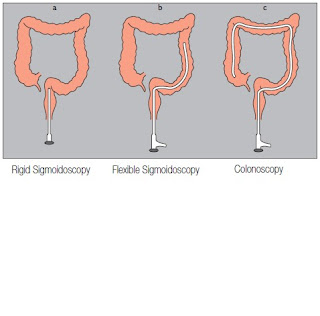If you have diarrhoea, with bleeding and abdominal pain, your doctor may suspect you have ulcerative colitis
particularly if you are a young adult or have a family history of IBD. You will need tests and
physical examinations to confirm a diagnosis. Initially routine blood tests can show whether there
is inflammation in the body and whether you have anaemia. Your stools may also be tested to
check whether your diarrhoea is caused by an infection. There are specific stool tests that can
show signs of inflammation, such as Faecal Calprotectin and Lactoferrin, but they are only
available in some centres.
If there is inflammation, you will need a further test to confirm the diagnosis by looking directly at
the inside of your colon, using a special instrument called an endoscope. This is a thin rigid or
flexible tube containing a tiny camera which a doctor or nurse specialist inserts into your rectum.
The test allows the specialist to see any inflammation, bleeding or ulcers on the lining of the colon.
From the diagram you will see that there are
three types of examinations using different
endoscopes. If you have a flexible sigmoidoscopy
or colonoscopy you will have to take
laxatives to clear your bowel.The specialist
may also take biopsies (small samples of
tissue) from the bowel lining. Biopsies are
sent to a laboratory for examination under a
microscope to confirm the diagnosis.

Sometimes you may have a barium enema x-ray to help show how much of the colon is affected.
To obtain the x-ray pictures, the specialist places a small tube in your anus. They then insert liquid
barium (a white, chalky, harmless substance) and air through the tube to outline the colon and rectum
.You can find more detailed information on tests in our booklet: Investigations for IBD.
Sometimes it is not possible to distinguish between UC and Crohn’s Disease and then the
diagnosis Indeterminate Colitis or IBD unclassified is used. This diagnosis is commonly given
to children.
particularly if you are a young adult or have a family history of IBD. You will need tests and
physical examinations to confirm a diagnosis. Initially routine blood tests can show whether there
is inflammation in the body and whether you have anaemia. Your stools may also be tested to
check whether your diarrhoea is caused by an infection. There are specific stool tests that can
show signs of inflammation, such as Faecal Calprotectin and Lactoferrin, but they are only
available in some centres.
If there is inflammation, you will need a further test to confirm the diagnosis by looking directly at
the inside of your colon, using a special instrument called an endoscope. This is a thin rigid or
flexible tube containing a tiny camera which a doctor or nurse specialist inserts into your rectum.
The test allows the specialist to see any inflammation, bleeding or ulcers on the lining of the colon.
From the diagram you will see that there are
three types of examinations using different
endoscopes. If you have a flexible sigmoidoscopy
or colonoscopy you will have to take
laxatives to clear your bowel.The specialist
may also take biopsies (small samples of
tissue) from the bowel lining. Biopsies are
sent to a laboratory for examination under a
microscope to confirm the diagnosis.

Sometimes you may have a barium enema x-ray to help show how much of the colon is affected.
To obtain the x-ray pictures, the specialist places a small tube in your anus. They then insert liquid
barium (a white, chalky, harmless substance) and air through the tube to outline the colon and rectum
.You can find more detailed information on tests in our booklet: Investigations for IBD.
Sometimes it is not possible to distinguish between UC and Crohn’s Disease and then the
diagnosis Indeterminate Colitis or IBD unclassified is used. This diagnosis is commonly given
to children.










0 comments:
Post a Comment